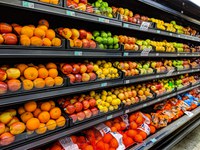Prairie Fare: Take steps to reduce food waste
(Click an image below to view a high-resolution image that can be downloaded)
I was cleaning out my refrigerator the other day. I felt bad when I found some shredded cheese riddled with mold. The bag of cheese was hiding in a drawer.
I could have saved that cheese by putting it in the freezer.
At times, I have sniffed milk before pouring some on my cereal. Sometimes, the milk has been well-beyond its prime.
Milk can be frozen for use in recipes.
Do you ever find less-than edible food lurking in your refrigerator? How about moldy bread in a bag on your countertop? Most people do.
Food costs more these days, so we need to take steps to use it while it remains safe and of high quality.
Unfortunately, much food is wasted in the U.S. annually. About 30% to 40% of our food supply is wasted, according to national statistics. That amounts to 133 billion pounds of food valued at $161 billion.
This has effects on American households’ pocketbooks. The average family of four loses $1,500 each year due to uneaten food.
Why does so much food get wasted? Sometimes we do not realize how much food we have on hand, and we might buy extra food. Keeping an inventory of what you have on hand may seem tedious, but it might also help save you money.
The U.S. Department of Agriculture and Environmental Protection Agency established a food loss and waste reduction goal in 2015. The goal is reduce waste by 50% by 2030. We have a lot of work to do in the next seven years.
Food “loss” occurs before the food ever reaches consumers. It happens during storage, processing and other phases of moving food to us. Food waste happens in grocery stores, restaurants, schools and at home.
What can you do to reduce food waste? We can take some steps as individuals to help prevent food waste.
Keep a list of what you need to buy on your refrigerator, as a note in your phone or whatever way works for you. That can help eliminate guessing what you need.
Make a meal plan. Try to use the foods you have on hand when writing a plan for the week. Cooking at home or meal-prepping for a few days can prevent the “what’s to eat?” dilemma. If you have a plan in place, you are less tempted to stop at a drive-through. Buy what you can use within a reasonable time frame. If a loaf of bread becomes moldy before you can use it, consider freezing the next loaf and taking out what you need.
Use your leftovers or “planned-overs” creatively. If you have chili one night, consider baked potatoes with chili and cheese later in the week. A roast beef can be Sunday dinner and later hot roast beef sandwiches or barbecue beef. If you have leftover vegetables, add them to soup or casseroles.
Consider composting vegetable peelings. Compost is organic material you can add to soil to help plants grow.
According to the EPA, food scraps and yard waste make up 20% to 30% of what we throw away; it could be composted instead. Making compost keeps these materials out of landfills, where they take up space and release methane, a greenhouse gas.
Search online for the “how to compost” guide from North Dakota State University Extension. For questions about food storage, search for the “food storage guide” and “food freezing guide” from NDSU Extension.
This recipe can help you use foods in your refrigerator, freezer or pantry.
Teriyaki Chicken and Pineapple Fried Rice
1 pound chicken (breast or tenderloin)
1/3 cup teriyaki sauce, low sodium
3 cups brown rice, cooked
2 cups pineapple, diced (fresh or canned)
1 cup frozen peas and carrots
1 cup onion, diced
2 tablespoons olive oil
2 teaspoons garlic, minced
1/4 teaspoon ground ginger
Preheat oven to 400 F. Line the sheet pan with foil for easy cleanup. Create a boat with a second piece of aluminum foil to fit half the pan size. Place the chicken in a single layer in the boat and drizzle with teriyaki sauce. Cook in oven for 15 minutes.
While chicken is cooking, add the remaining ingredients to a bowl and stir to combine. After the chicken is done cooking for 15 minutes, add the rice mixture to the other half of the sheet pan. Spoon teriyaki sauce over chicken as necessary and return the pan to the oven. Cook for an additional 10 minutes or until chicken reaches 165 F.
Makes six servings. Each serving has 310 calories, 6 grams (g) fat, 22 g protein, 42 g carbohydrate, 4 g fiber and 360 milligrams sodium.
(Julie Garden-Robinson, Ph.D., R.D., L.R.D., is a North Dakota State University Extension food and nutrition specialist and professor in the Department of Health, Nutrition and Exercise Sciences. Follow her on Twitter @jgardenrobinson)
NDSU Agriculture Communication – March 2, 2023
Source: Julie Garden-Robinson, 701-231-7187, julie.garden-robinson@ndsu.edu
Editor: Elizabeth Cronin, 701-231-5391, elizabeth.cronin@ndsu.edu




